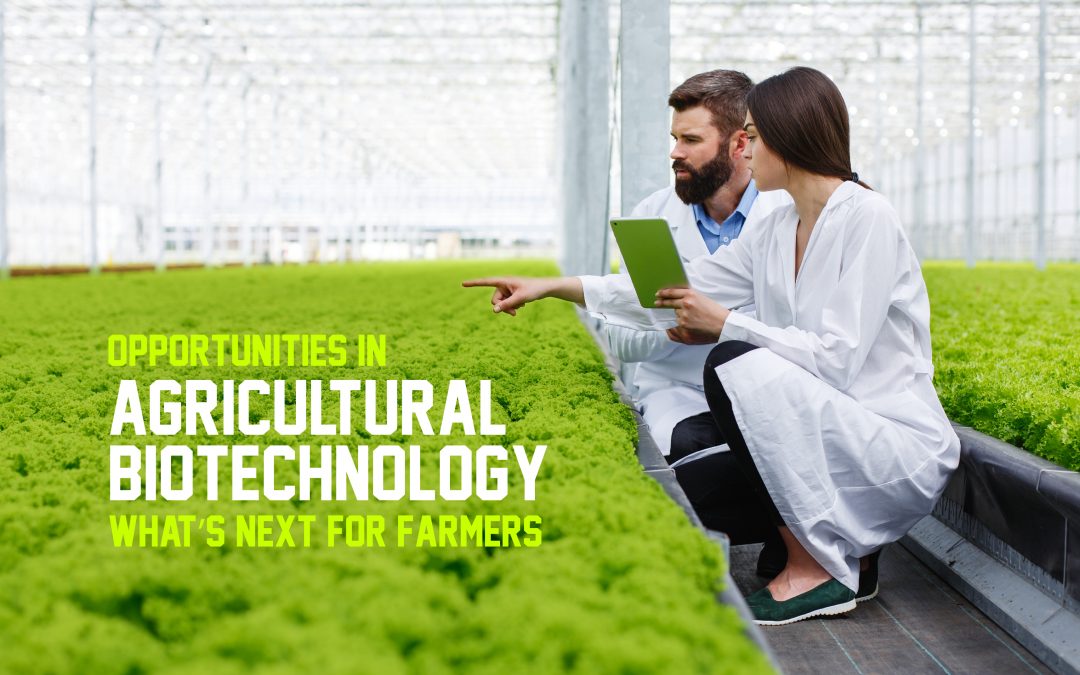In the ever-evolving landscape of agriculture, biotechnology stands out as a beacon of innovation and promise. As we face global challenges like climate change, food security, and sustainability, agricultural biotechnology offers farmers a suite of tools to enhance productivity, resilience, and environmental stewardship. So, what’s next for farmers in this brave new world of agricultural biotechnology? Let’s explore the exciting opportunities ahead.
1. Genetically Modified Crops: Enhancing Yield and Resilience
Genetically modified (GM) crops have been at the forefront of agricultural biotechnology for decades. These crops are engineered to exhibit desirable traits such as pest resistance, herbicide tolerance, and improved nutritional content. For farmers, GM crops mean higher yields, reduced reliance on chemical inputs, and greater resilience to environmental stresses.
Real-Time Usage and Examples:
- Bt Cotton and Bt Corn: These crops are engineered to produce a toxin derived from the bacterium Bacillus thuringiensis (Bt), which is harmful to certain pests but safe for humans and other non-target organisms. Bt cotton and Bt corn have significantly reduced the need for chemical insecticides, leading to cost savings and environmental benefits.
- Golden Rice: Engineered to produce beta-carotene, a precursor of Vitamin A, Golden Rice aims to address Vitamin A deficiency, which is prevalent in many developing countries. This biofortified crop has the potential to improve public health outcomes significantly.
What’s Next?
- Stacked Traits: Future GM crops will combine multiple beneficial traits, offering enhanced performance against a wider range of challenges. For example, SmartStax corn, developed by Monsanto (now Bayer), combines eight different traits for insect resistance and herbicide tolerance.
- Gene Editing: Techniques like CRISPR-Cas9 enable precise edits to plant genomes, allowing for the development of crops with improved traits more quickly and efficiently than traditional genetic modification methods. An example is the CRISPR-edited mushroom that resists browning, extending its shelf life and reducing food waste.
2. Precision Agriculture: Maximizing Efficiency
Precision agriculture leverages technology to optimize farming practices. Through the use of sensors, GPS mapping, and data analytics, farmers can make more informed decisions about planting, irrigation, fertilization, and harvesting.
Real-Time Usage and Examples:
- Soil Sensors: These devices measure soil moisture and nutrient levels, providing real-time data that helps farmers apply water and fertilizers more efficiently. For example, a farmer using soil sensors can avoid over-irrigation, which conserves water and reduces runoff.
- GPS-Enabled Tractors: These machines use GPS technology to follow precise paths in fields, ensuring uniform planting and minimizing overlaps. John Deere’s AutoTrac system is a popular example, helping farmers increase productivity and reduce fuel usage.
What’s Next?
- Drones and Satellites: These tools will provide real-time data on crop health, soil conditions, and weather patterns, allowing for more precise and timely interventions. Companies like DroneDeploy offer platforms for aerial imaging and analysis, helping farmers monitor large areas quickly.
- AI and Machine Learning: Advanced algorithms will analyze data to predict crop outcomes, recommend optimal practices, and even automate tasks, reducing labor costs and increasing efficiency. For instance, IBM’s Watson Decision Platform for Agriculture uses AI to provide insights on crop health and weather conditions.
3. Biopesticides and Biofertilizers: Sustainable Inputs
Traditional chemical pesticides and fertilizers have long been criticized for their environmental impact. Biopesticides and biofertilizers, derived from natural sources, offer a sustainable alternative.
Real-Time Usage and Examples:
- Bacillus thuringiensis (Bt): As a biopesticide, Bt is used to control insect pests in organic farming. Products like Dipel and Thuricide contain Bt and are used on crops like cabbage and tomatoes to manage caterpillar pests.
- Mycorrhizal Fungi: These biofertilizers form symbiotic relationships with plant roots, enhancing nutrient uptake and improving soil health. Companies like Mycorrhizal Applications offer products that help farmers boost crop yields naturally.
What’s Next?
- Microbial Solutions: Research is uncovering beneficial microbes that can promote plant growth, enhance nutrient uptake, and protect against pests and diseases. For example, Pivot Bio’s PROVEN product uses nitrogen-fixing bacteria to provide crops with a sustainable nitrogen source.
- Integrated Pest Management (IPM): Combining biopesticides with traditional methods in an integrated approach will optimize pest control while minimizing environmental impact. Farmers will use tools like pheromone traps, crop rotation, and resistant varieties to manage pests more effectively.
4. Climate-Resilient Crops: Adapting to Change
Climate change poses a significant threat to agriculture, with increasing temperatures, changing precipitation patterns, and more frequent extreme weather events. Biotechnology is crucial in developing crops that can withstand these challenges.
Real-Time Usage and Examples:
- Drought-Tolerant Corn: Developed by Monsanto (Bayer), DroughtGard hybrids are designed to perform better under water-limited conditions, helping farmers maintain yields during droughts.
- Salt-Tolerant Rice: The International Rice Research Institute (IRRI) has developed rice varieties that can tolerate saline conditions, allowing farmers to grow rice in areas affected by saltwater intrusion.
What’s Next?
- Drought-Tolerant Varieties: Biotechnology will continue to produce crops that can thrive in water-scarce conditions, crucial for regions facing prolonged droughts. For instance, researchers are working on drought-tolerant wheat and soybean varieties.
- Heat-Resistant Crops: Research is focused on developing crops that can maintain high yields even under high-temperature stress. Scientists are exploring genes from heat-tolerant wild relatives of crops to incorporate into commercial varieties.
5. Nutritional Enhancements: Feeding a Growing Population
As the global population grows, ensuring access to nutritious food is paramount. Biotechnology can enhance the nutritional content of crops, addressing deficiencies and improving public health.
Real-Time Usage and Examples:
- Golden Rice: As mentioned earlier, this biofortified rice addresses Vitamin A deficiency, which affects millions of children in developing countries.
- Iron-Fortified Beans: Researchers at the International Center for Tropical Agriculture (CIAT) have developed beans with higher iron content to combat iron deficiency anemia in regions where beans are a staple food.
What’s Next?
- Biofortification: Crops will be engineered to contain higher levels of essential vitamins and minerals. Examples include Vitamin D-enriched tomatoes and zinc-fortified wheat.
- Functional Foods: Biotechnology will enable the development of crops with added health benefits, such as increased antioxidant content or enhanced immune-boosting properties. For instance, purple tomatoes rich in anthocyanins, which have antioxidant properties, are being developed to offer health benefits beyond basic nutrition.
Conclusion
The future of agriculture lies at the intersection of technology and biology. For farmers, embracing agricultural biotechnology means more than just adopting new tools—it’s about transforming their practices to meet the demands of a changing world. From genetically modified crops and precision agriculture to biopesticides and climate-resilient varieties, the opportunities are vast and varied. As these technologies continue to advance, farmers will be better equipped to produce more food, more sustainably, and more resiliently, ensuring a secure food future for all.
By staying informed and adaptable, farmers can navigate the complexities of modern agriculture and seize the opportunities that biotechnology presents, paving the way for a prosperous and sustainable future.












